Everybody needs to carry water with them while hiking. Hydration is one of the Ten Essentials that you always need when you hike, and one way to make sure you stay hydrated is by carrying a water bottle and drinking from it regularly.
Reusable water bottles are a multi-billion dollar market, expected to reach $11.5 billion by 2027. While there are lots of stylish water bottles out there, not all of them are great for hiking. If you’re wondering how to choose a water bottle for hiking, here is a complete guide to everything you need to know about hiking water bottles.
Water Bottle Styles and Materials
Water bottles come in several different styles and materials.
- Collapsible/Foldable Bottles: These bottles are soft-sided and collapse or fold to make them extremely packable.
- Glass Bottles: These heavy bottles are made of glass and often have some kind of silicone or rubberized sleeve to protect them.
- Plastic Bottles: These bottles are made from plastic– frequently recycled plastic. They are lightweight and may have BPA.
- Plastic Bottles– BPA Free: These bottles are made from plastic that’s free from BPA, a chemical compound used in the production of certain types of plastics and resins. BPA is known to be an endocrine disruptor, but there is an ongoing scientific debate about if exposure can actually harm people. (For more on that, scroll down!)
- Steel Bottles– Double Wall/Vacuum: These bottles are made of steel and have an inner and outer wall. A vacuum seal forms between the two, making them insulated for hot or cold beverages.
- Steel Bottles– Single Wall: These bottles have only a single metal wall, making them somewhat insulating but not as much as a vacuum-sealed bottle. They are lighter and less expensive than double-walled bottles.
- Bottles with Filters: These bottles have built-in water filters, making virtually any water source safer.
- Bottles with Straws: These water bottles have a straw built into the lid that pops up when you push a button. They’re very easy to drink from and less likely to spill if you’re walking while you drink.
- Wide-Mouthed Bottles: These water bottles have large mouths, so it’s easier to put ice in them.
Choosing a Water Bottle
Choosing a water bottle isn’t just about capacity– although that is important. You need to consider the whole water bottle and how it will function when you take it out hiking.
Water Bottle Types Pros and Cons
Each type of water bottle construction has its pros and cons. While all of these can be good options for hiking, each material has characteristics that determine how useful it will be for you.
| Water Bottle Type | Pros | Cons |
| Collapsible/Foldable | Extremely lightweight; portable; collapses to save space; easy to clean; usually BPA-free | No insulation; sometimes prone to leakage; plastic taste; not as durable as other types of water bottles |
| Glass | Easy to clean; no plastic or metallic taste; aesthetically pretty; can always go in the dishwasher | Fragile; heavy; poor insulation; may chip in a backpack; limited capacity |
| Plastic | Lightweight; durable; affordable; convenient; lots of designs and lid options; may be made from recycled materials | Can absorb flavors and odors; plastic taste; poor insulation; concerns over chemicals like BPA |
| Plastic- BPA Free | Addresses the BPA concern; lightweight; durable; lots of designs and lid options | Still made from plastic, may not be recycled; can absorb odors and flavors; poor insulation |
| Steel- Double Wall | Excellent insulation; extremely durable; resistant to odors, flavors, and stains | Can be heavy; doesn’t always fit in your cup holder or side backpack pocket; usually the most expensive type of water bottle; may have a metallic taste |
| Steel- Single Wall | Durable; lighter than double walled bottles but still as tough; resistant to odors and flavors; lots of designs and lid options | Less effective insulation; sides may become hot when you carry hot liquids; condensation can form on the outside if carrying cold liquids |
Capacity and Weight
The capacity and weight of your water bottle will vary widely depending on the style of bottle and its capacity. For example, the Nalgene Ultralite Wide Mouth bottle and Klean Kanteen TKWide Recycled Insulated bottle contain the same amount of water– but the Klean Kanteen weighs more than 5 times as much as the Nalgene bottle!
Measurability
If you want to use the water you bring with you for cooking, or just want to measure how much you’re drinking over the course of a day, some water bottles have markings on the side that show you exactly how much you’ve had and how much you have left. For example, Nalgene has measure marks for both milliliters and fluid ounces, making them great for keeping track.
Sustainability
For many hikers, part of enjoying the outdoors is choosing gear that supports sustainable resource use. One of our biggest polluters is bottled water. Bottled water has an environmental impact 3,500 times greater than tap water, and only about 30% of all recyclable plastic water bottles actually get recycled. This puts millions of pounds of plastic waste into our oceans and landfills every year, and is part of the reason that the reusable water bottle industry has become so large. It’s just as convenient to carry a reusable bottle.
When you’re choosing a water bottle, look for one that uses post-consumer or recycled materials. It’s also much more sustainable to choose a bottle manufactured in the United States; this means that less fuel is used transporting it across the ocean. One of the most popular hiking water bottle brands, Nalgene, makes their bottles in Rochester, NY using as much recycled plastic as possible, making them a more sustainable choice than many other plastic alternatives.
Water Bottles Vs Hydration Bladders
Water bottles and hydration bladders are both popular ways to carry water while hiking. Many hikers like to carry both, starting out with a full hydration bladder and carrying extra water as a backup.
Not sure which to carry? Here’s the key differences between the two.
| Water Bottles | Hydration Bladders |
| Typically rigid and cylindrical, though some can collapse | Flexible, shaped like a pouch or bag |
| Capacities ranging from 12 to 32 ounces (355 to 946 ml), sometimes larger | Larger capacities, ranging from 50-100+ ounces (1.5-3+ liters) |
| Easy to carry; compact, with features like built-in handles and attachment points | Require a backpack with a special pouch and hole for the hose, or a hydration pack. (You can use a regular backpack as well) |
| Drink out of a spout or opening | Drink out of a hose and bite valve mechanism |
| Provides quick and easy access to water | Requires routing the hose and bite valve for easy access, may require more effort to pack, but easier to drink |
| Can create imbalance weight distribution | Distributes the weight of water evenly |
| Easier to clean, can accommodate brushes | Narrow opening requires specialized tools or cleaning tablets |
| Versatile and easy to carry anywhere | Requires special gear– not so useful for everyday use |
| Requires hands | Hands-free hydration |
In most circumstances, you can freely choose between either or both. If you’re day hiking, you probably just need a water bottle or two. Choose based on your activity and how much water you’re comfortable carrying with you!
Water Bottles at Elevation
If you’re a mountaineer or like to hike at high elevation, you should be aware of pressure changes and what they can do to your water bottle. If you have a vacuum bottle that has a full-screw on lid, the pressure change at high elevations could make it impossible or very difficult to open. If you plan on climbing a lot of elevation, make sure you have a quarter-turn opening, a pop-up straw, or some other way to release the pressure.
Water Bottles for Long-Distance Hiking
If you’re thru-hiking, backpacking, trekking, or other style of hiking where you don’t have frequent access to treated, clean water, you might not be able to take all the water you need with you. In that case, you don’t have to find a two-gallon tankard of a water bottle; you should instead choose a water filter or purifier and get used to the idea of drinking from natural water sources.
Long-distance hikers also tend to appreciate a water bottle with a high capacity to weight ratio. The lightest bottle on our list is also the largest, the Platypus Platy 2.0. If you’re looking for a bottle for long-distance hiking, be sure to check that one out.
Why Choose A BPA-Free Water Bottle
If you carry a plastic bottle, you may be worried about BPA. As we mentioned earlier, BPA is used in the manufacture of some plastics. The FDA maintains that BPA can safely be used in product packaging, but the safe dose for humans is still debatable. Even the most modern studies can’t agree on BPA’s risk or safety, and its long-term effects are still unknown.
Because of this, many hikers prefer to have a water bottle that can’t leach BPA into their drink. The easiest way to determine if your water bottle is truly BPA-free is to turn it upside down and look at its identification code. Plastic bottles labeled 1, 2, 4, and 5 are BPA-free. Plastic bottles labeled with 3, 6, and 7 are not.
The Best Water Bottles for Hiking
So how do the best of the best compare to each other? Here’s a quick guide to the water bottles we’re featuring here.
| Model | Material | Empty Weight | Capacity | Key Feature |
| CamelBak Eddy+ Renew | BPA-Free Plastic | 6.6 ounces | 25 ounces | Integrated straw |
| HydraPak Flux | BPA-Free Plastic (TPU) | 2.7 ounces | 34 ounces | Foldable |
| HydraPak Stow | BPA-Free Plastic (TPU) | 1.6 ounces | 17 ounces | Foldable |
| Hydro Flask Standard Mouth | Double-wall stainless steel | 13.1 ounces | 24 ounces | Insulated |
| Katadyn BeFree | BPA-Free Plastic (TPU) | 2.2 ounces | 34 ounces (1 L) | Integrated filter |
| Klean Kanteen TKWide Recycled Insulated | Triple-wall stainless steel | 20.1 ounces | 32 ounces | Durable |
| LifeStraw Go | BPA-Free Plastic (Tritan) | 7.8 ounces | 22 ounces | Integrated filter |
| Nalgene Ultralite Wide Mouth | BPA-Free Plastic (HDPE) | 3.8 ounces | 32 ounces | Ultra light |
| Nalgene Wide Mouth | BPA-Free Plastic (Tritan) | 6.3 ounces | 32 ounces | Durable |
| Owala FreeSip Stainless Steel | Double-wall stainless steel | 13.5 ounces | 24 ounces | Integrated straw |
| Platypus Platy 2.0 | BPA-Free Plastic | 1.3 ounces | 70 ounces (2 L) | Ultra light |
| Yeti Rambler | Double-wall stainless steel | 22.4 ounces | 26 ounces | Insulated |
Best Ultralight Water Bottles
These water bottles all weigh less than 4 ounces– perfect for ultralight backpackers or anybody who wants to save weight.
Nalgene 32-Ounce Ultralite Wide Mouth
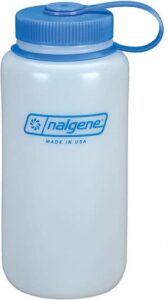 Nalgene’s ultra-light bottles use HDPE, a type of plastic that is extremely lightweight. These bottles are tough and durable, and while they don’t quite have that classic Nalgene aesthetic, they’ll carry your water and get the job done.
Nalgene’s ultra-light bottles use HDPE, a type of plastic that is extremely lightweight. These bottles are tough and durable, and while they don’t quite have that classic Nalgene aesthetic, they’ll carry your water and get the job done.
- Capacity: 32 ounces (also comes in 16 and 48 ounce capacities)
- Empty Weight: 3.8 ounces
- Material: HDPE BPA-free plastic
- Pros: Extremely light, budget friendly, extremely durable, easy to use
- Cons: Cap is not as durable as the bottle (replacements are available), wide mouth can be awkward to drink from, not as durable as tritan bottles, poor insulation
- Price: $11.99
Platypus Platy 2.0
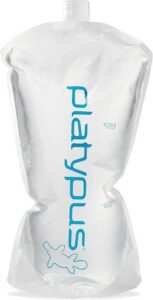 At a mere 1.3 ounces, the Platypus Platy 2.0 is the lightest bottle on our list. This feather-light bottle has a massive 70 ounce (2 liter) capacity and has become very popular with thru-hikers who want to maximize capacity while minimizing the weight and space their water bottles take up.
At a mere 1.3 ounces, the Platypus Platy 2.0 is the lightest bottle on our list. This feather-light bottle has a massive 70 ounce (2 liter) capacity and has become very popular with thru-hikers who want to maximize capacity while minimizing the weight and space their water bottles take up.
- Capacity: 70 ounces
- Empty Weight: 1.3 ounces
- Material: BPA-free plastic
- Pros: Weighs about as much as an AA battery, collapses to a tiny size when empty, pairs easily with water filters and various Platypus caps to make drinking easier
- Cons: No insulation, difficult to drink from, doesn’t fit in a side pouch or cupholder
- Price: $18.95
Best Insulated Water Bottles
These water bottles are our favorite double-walled steel water bottles. They’ll keep your hot drinks hot and your cold drinks cold!
Hydro Flask Standard Mouth 24 Ounces
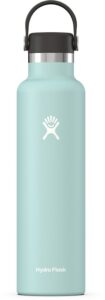 This insulated bottle is rated to keep hot drinks hot for 12 hours and cold drinks cold for 24 hours, and it lives up to this promise.
This insulated bottle is rated to keep hot drinks hot for 12 hours and cold drinks cold for 24 hours, and it lives up to this promise.
- Capacity: 24 ounces (also comes in 18 and 21 ounce capacities)
- Empty Weight: 13.1 ounces
- Material: Double-walled steel
- Pros: Excellent insulation, good materials, multiple cap options including a cap with an integrated straw
- Cons: Harder to clean than a wide-mouthed bottle, heavier than we would want for any long distance hike
- Price: $24-$40
Yeti Rambler 26 Ounces with Chug Cap
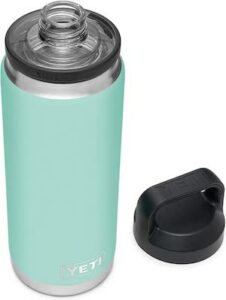 First rising to fame for their coolers, Yeti’s water bottles are tough, durable, and have exceptional insulation. The downside is the weight; these bottles are very heavy.
First rising to fame for their coolers, Yeti’s water bottles are tough, durable, and have exceptional insulation. The downside is the weight; these bottles are very heavy.
- Capacity: 26 ounces (also available in 18, 36, 46, and 64 ounce capacities)
- Empty Weight: 22.4 ounces
- Material: Double-walled steel
- Pros: Easy to drink from, cap options including one with an integrated straw, great insulation
- Cons: Heavy– possibly too heavy for comfortable hiking, too big for cupholders
- Price: $40
Best Foldable Water Bottles
These water bottles will crush down, fold, or roll to a tiny size in your pack. If you want to save space, these are the bottles for you.
HydraPak Stow 500 mL
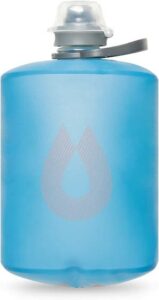 This water bottle collapses to a size that can fit in your pocket. We especially like the integrated strap that keeps it contained once you roll it up.
This water bottle collapses to a size that can fit in your pocket. We especially like the integrated strap that keeps it contained once you roll it up.
- Capacity: 17 ounces/500 ml (also comes in 34 ounce capacity)
- Empty Weight: 1.6 ounces
- Material: TPU plastic
- Pros: Extremely light, budget friendly, compatible with most 28mm threaded water filters
- Cons: Flip-top cap can crack, less durable than hard bottles
- Price: $13-$16
HydraPak Flux 1L
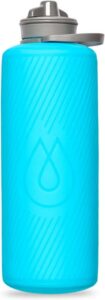 While the Flux doesn’t collapse quite as small as the Stow, this collapsible offering from HydraPak is one of the easiest collapsible water bottles to use. The material offers a really good grip, and you don’t have to worry about it collapsing as you fill it.
While the Flux doesn’t collapse quite as small as the Stow, this collapsible offering from HydraPak is one of the easiest collapsible water bottles to use. The material offers a really good grip, and you don’t have to worry about it collapsing as you fill it.
- Capacity: 34 ounces (a 50 ounce capacity is also available)
- Empty Weight: 2.7 ounces
- Material: Double-layer TPU plastic laminate
- Pros: Easy to use twist cap, durable, lightweight
- Cons: Plastic taste
- Price: $16-$27
Most Durable Water Bottles
You could drop these water bottles down the side of a mountain and they’d come away fine. These ultra-durable bottles can take anything you throw at them (or throw throw at).
Nalgene Wide Mouth 32 Ounces
 These bottles are everywhere, and for good reason. Lightweight and made from durable and recycled Tritan plastic, their ease of use, light weight, and good capacity have made them a favorite of hikers for decades.
These bottles are everywhere, and for good reason. Lightweight and made from durable and recycled Tritan plastic, their ease of use, light weight, and good capacity have made them a favorite of hikers for decades.
- Capacity: 32 ounces (also available in 16 and 48 ounce capacities)
- Empty Weight: 6.3 ounces
- Material: BPA-free Tritan plastic
- Pros: Extremely durable, lightweight, inexpensive, lots of color and design options
- Cons: Poor insulation, and the cap strap isn’t as durable as the rest of the bottle; you may need a new cap in your bottle’s lifetime
- Price: $15-$20 for some limited edition colorways
Klean Kanteen TKWide Recycled Insulated 32 Ounces
 This double-walled insulated water bottle has a twist cap with an optional stainless steel straw. It has a well-designed cap with few failure points, and its impact base cap makes it dent and chip resistant.
This double-walled insulated water bottle has a twist cap with an optional stainless steel straw. It has a well-designed cap with few failure points, and its impact base cap makes it dent and chip resistant.
- Capacity: 32 ounces (12, 20, and 24 ounce capacities also available)
- Empty Weight: 20.1 ounces
- Material: 90% recycled double-wall stainless steel
- Pros: Well-insulated, extremely durable, sturdy carrying handle
- Cons: Expensive, heavy
- Price: $42.95-$45
Best Water Bottles With Straws
Don’t want to worry about spills? These water bottles make it easy to drink without stopping.
CamelBak Eddy+ Renew 25 Ounce
 One of the most frustrating things about many water bottles with integrated straws is that the straw won’t let you drink all of the water. Not true with the CamelBak Eddy+; the straw is one of our favorite things about it. It’s well-designed and easy to drink from.
One of the most frustrating things about many water bottles with integrated straws is that the straw won’t let you drink all of the water. Not true with the CamelBak Eddy+; the straw is one of our favorite things about it. It’s well-designed and easy to drink from.
- Capacity: 25 ounces (20 and 32 ounce capacities also available)
- Empty Weight: 6.6 ounces
- Material: BPA-free plastic
- Pros: Leakproof lid, made with 50% recycled plastic, well-designed straw, nicely priced
- Cons: Poor insulation
- Price: $15-$16
Owala FreeSip Stainless Steel 24 Ounces
 This relative newcomer to the water bottle market has quickly risen in popularity thanks to an innovative cap design that lets you choose between a straw or standard water bottle opening.
This relative newcomer to the water bottle market has quickly risen in popularity thanks to an innovative cap design that lets you choose between a straw or standard water bottle opening.
- Capacity: 24 ounces (also comes in 19, 32, and 40 ounce capacities)
- Empty Weight: 13.4 ounces
- Material: Triple-layer stainless steel
- Pros: Great insulation, easy to drink from, choice between integrated straw or wide-mouth opening, fits in a cupholder
- Cons: Carrying loop isn’t very ergonomic, more moving parts means more potential for failure down the line
- Price: $18.50-$28
Best Water Bottles With Filters
If you want a built-in filter, these bottles are just what you need.
Katadyn BeFree 1L
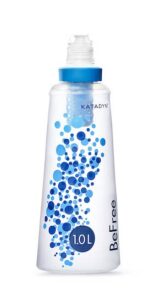 This soft-sided, lightweight filtration system is packable and durable enough for all of your adventures.
This soft-sided, lightweight filtration system is packable and durable enough for all of your adventures.
- Capacity: 34 ounces (20 ounce capacity also available)
- Empty Weight: 2.2 ounces
- Material: TPU plastic
- Pros: Lightweight, easy to use, makes it easy to filter water and then pour into another bottle (so you can share clean water with your friends)
- Cons: Does not filter viruses, soft sided design requires two hands to drink from, shorter filter lifespan than other options– filter rated for 1000 L of water (264 gallons)
- Price: $47.95-$49.95
LifeStraw Go 22 Ounces
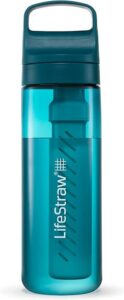 LifeStraw’s straw-based water filters work just as well with an integrated bottle. Their filters are known for their ease of use and efficacy– you don’t have to worry about parasites, bacteria, debris, or even microplastics.
LifeStraw’s straw-based water filters work just as well with an integrated bottle. Their filters are known for their ease of use and efficacy– you don’t have to worry about parasites, bacteria, debris, or even microplastics.
- Capacity: 22 ounces (a 34 ounce capacity is also available)
- Empty Weight: 7.8 ounces
- Material: BPA-free plastic
- Pros: Long lifespan (the filter is rated for 1000 gallons of water), easy to drink from, great bacterial filtration
- Cons: Bulky, does not filter viruses.
- Price: $44.95
How does your favorite water bottle compare to the ones on our list? The next time you’re in the market for a new water bottle for hiking, be sure to check our recommendations to find the perfect bottle for you.
Max DesMarais is the founder of hikingandfishing.com. He has a passion for the outdoors and making outdoor education and adventure more accessible. Max is a published author for various outdoor adventure, travel, and marketing websites. He is an experienced hiker, backpacker, fly fisherman, backcountry skier, trail runner, and spends his free time in the outdoors. These adventures allow him to test gear, learn new skills, and experience new places so that he can educate others. Max grew up hiking all around New Hampshire and New England. He became obsessed with the New Hampshire mountains, and the NH 48, where he guided hikes and trail runs in the White Mountains. Since moving out west, Max has continued climbed all of the Colorado 14ers, is always testing gear, learning skills, gaining experience, and building his endurance for outdoor sports. You can read more about his experience here: hikingandfishing/about
